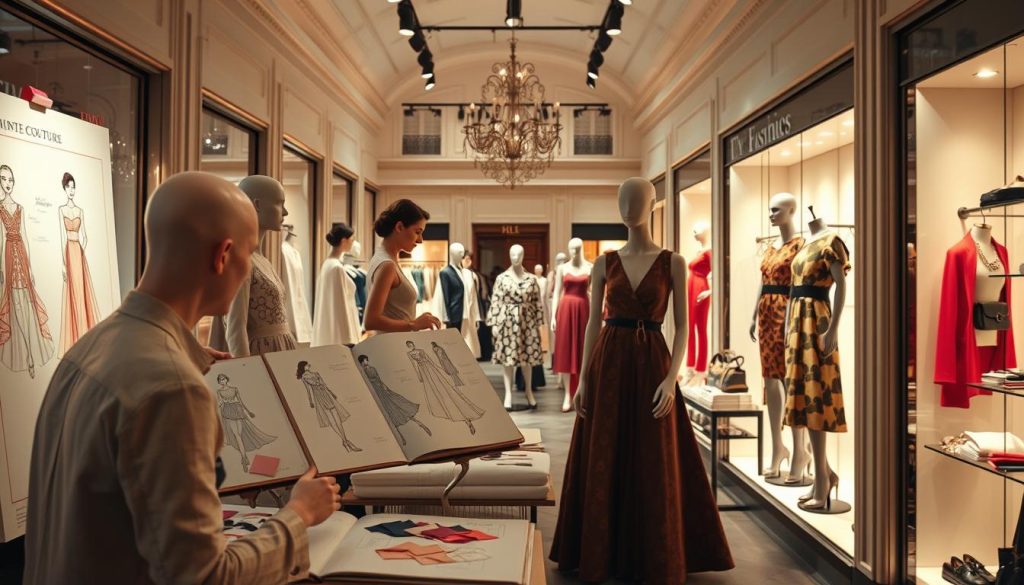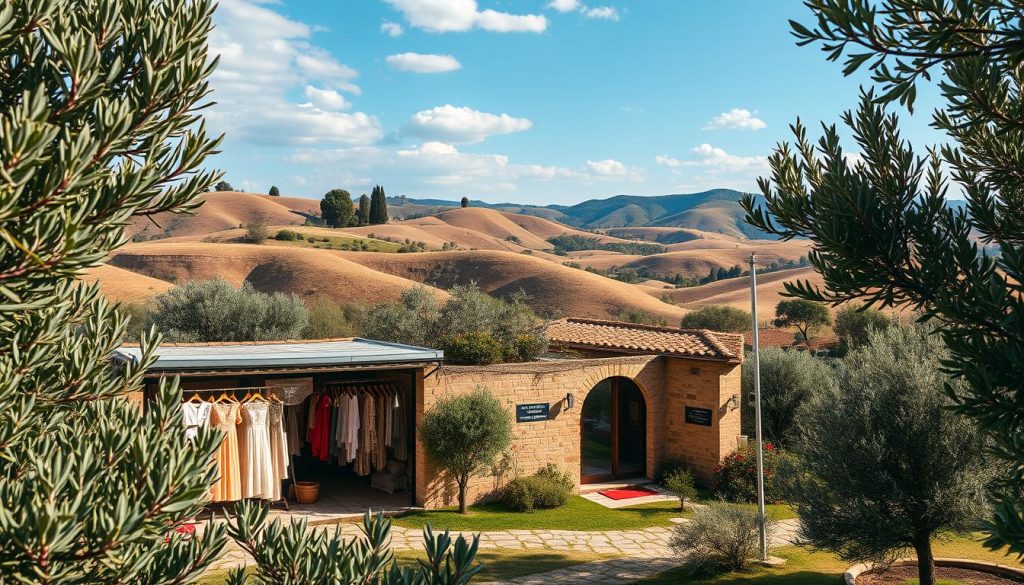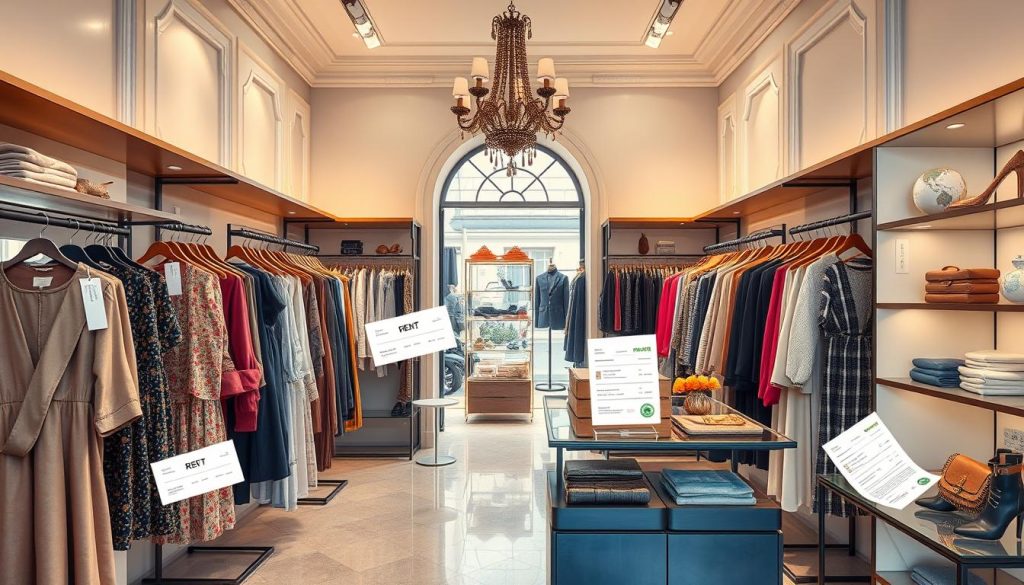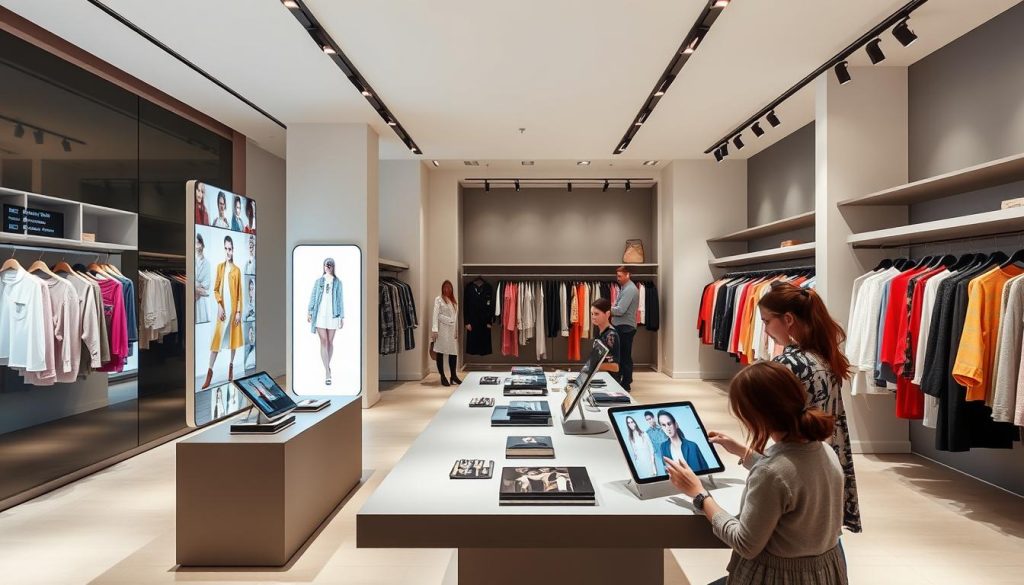“Fashion is about dreaming and making other people dream.” – Donatella Versace. This quote really hits home when we think about starting a clothing boutique in Italy. Italy is at the heart of the fashion world. It’s a place where style, creativity, and culture come together, making it a dream spot for fashion entrepreneurs.
But starting a clothing boutique is a big challenge. It takes around 50,000 euros to get started. We need to plan carefully and have a clear vision. The Italian fashion scene is lively but also complex. We have to handle everything from design to selling to customers.
We’ll look at the key steps to make our boutique a success. We’ll focus on the operational, creative, and financial sides. Knowing the market, how customers behave, and the latest fashion trends is crucial for our journey.
Understanding the Fashion Industry in Italy
The Italian fashion industry is full of life and complexity. It has a long history and a focus on new ideas. Famous brands like Gucci, Prada, and Versace make Italy key in setting global fashion trends. This sector is always changing, driven by what people want, the seasons, and big events.
To start our clothing boutique, knowing the market is key. Watching events like Milan Fashion Week gives us a peek into new styles and trends. These events show Italy’s big role in the world of fashion.
There’s a big move towards being green in the fashion world. Many Italian brands are now using eco-friendly methods and focusing on fair production. This matches what today’s shoppers want, who care more about what they buy.
The skill in places like Tuscany and Emilia-Romagna adds a lot to Italian fashion. They’re known for their leather and fine clothes. Knowing this helps us find top-notch materials for our boutique, meeting what customers now expect.

Knowing who we’re up against is important for our boutique. With both old and new influences, we need to find our spot. We aim to serve specific markets while keeping up with Italy’s creative fashion spirit.
Defining Our Vision for the Boutique
Creating a clear vision for our boutique is key. It sets the tone for our unique style and values. This vision guides our choices in products, customer service, and branding.
Looking at successful boutiques, we see a pattern. Chanel stands for luxury and timeless beauty. Zara focuses on being inclusive and easy to reach. By learning from them, we can craft our own identity and attract the right customers.
Getting inspiration from art, culture, and fashion history helps us stand out. A good vision statement is both inspiring and practical. It shows how we aim to make a difference in the community and the fashion world.
A mission statement is the heart of our vision. It outlines what we want to achieve in the boutique world. By including our values in this statement, we can share our goals and build loyalty with customers. Defining our vision means thinking about our brand’s future and how we want to shape the fashion industry.

Conducting Market Research for a Clothing Boutique
Understanding our target audience is key in the clothing boutique market. We need to know what they like and how they shop. This helps us create a shopping experience that they’ll love.
We start by making customer personas. These are based on things like age, gender, and what they do. This gives us a clear idea of who our customers are. We also look at their values and lifestyle to connect with them better.

Looking at our competitors is also important. We find out what they do well and what they don’t. This helps us improve our products and marketing. We learn that fashion shoppers buy about four times a year and spend more than others.
More than half of buyers want brands to be open and eco-friendly. We might make our brand more transparent and green.
We use both old and new ways to research the market. Traditional methods like talking to people and surveys are used with digital tools and AI. These tools give us quick insights from social media and big data. Surveys give us numbers, while talking to people helps us understand why they buy what they do.
Tools like Netquest are great for getting detailed market studies. They help us see trends in the clothing boutique world. By setting clear goals for our research, we can track our progress and make smart choices based on what our customers want.
Crafting a Comprehensive Business Plan
Creating a solid business plan is key for our clothing boutique. It will guide us, outlining the steps to make our dream a reality.
Our plan should cover important areas:
- Objectives: Clearly state our goals, like entering a specific market or hitting sales targets in the first year.
- Target Market: Find our perfect customers through market research. We’ll look at age, income, and lifestyle to match our products.
- Budgeting: List expected start-up costs, like buying stock, renting a shop, and marketing.
- Operational Strategy: Explain how we’ll run the business. This includes staff roles, supplier relationships, and managing stock.
It’s important to make financial forecasts for the first six months and beyond. This part will show our revenue goals and how we’ll manage money. A good pricing strategy keeps us competitive and attractive to our target audience.
Also, a detailed marketing plan is crucial. We’ll use online platforms and social media to build a strong brand. This will help us reach more customers and increase foot traffic.

Finally, knowing the rules is essential. Our plan must cover necessary registrations, licenses, and insurance. With a well-thought-out plan, we can tackle the challenges of starting our boutique and aim for success.
Understanding the Costs of Starting a Boutique
Starting a clothing boutique requires understanding the financial side. The costs can change a lot, depending on where you are and how you plan to run your business. A good starting point is to budget around €50,000 for a small shop. This should cover initial expenses like rent, making the place look good, buying stock, and paying staff.

Planning your finances is key. We need to list all our spending and look for ways to fund our boutique. This is to keep it afloat in the early days. Key costs include:
- Business equipment: ranging from $5,000-$15,000.
- Initial inventory and supplies: between $3,000-$5,000.
- Business licenses and permits: estimated at $800-$1,500.
- Renovation and construction expenses: varying from $20,000-$50,000.
- Annual business insurance: around $500-$1,500.
- Marketing and advertising budget: which may require $2,000 to $10,000 initially.
We also need to think about ongoing costs like bills, insurance, and maybe growing the business. Having a 10% contingency fund is wise. This helps us deal with unexpected problems. Good financial planning helps us make smart choices, leading to success in a tough market.
Identifying the Right Location for Your Boutique
Choosing the right spot for our boutique is crucial. It affects how visible we are and who we attract. We must find a place that balances high foot traffic and affordable rent. Watching where our potential customers go can help us succeed.
Here are some important things to think about:
- Local Demographics: Knowing who lives nearby helps us serve our target audience better.
- Proximity to Competitors: Being close to other boutiques can bring in more people. But too many might make us less noticeable.
- Ambiance: A welcoming space draws in customers and shows off our brand well.
It’s vital to carefully look at different locations. We should consider not just the immediate area but also future growth. A smart choice can make our boutique stand out and thrive in the fashion world.

Strategically Sourcing Products and Materials
Finding the right products and materials is key for our clothing boutique. We focus on quality and sustainability. This helps us build strong ties with local makers and suppliers.
By doing this, we improve our product range. We also offer stylish and innovative items that our customers love.
In the textile world, we have different ways to source. We can make things locally or buy from abroad. Each method has its own advantages and disadvantages.
Understanding how things are made is crucial. It affects the quality of what we sell. Knowing about fabric weaving, cutting, and sewing helps us make better choices.
Supply chain management is also vital. Better coordination and sharing of information help us keep products in stock. This saves costs and meets customer needs quickly.
As we source products, we must focus on sustainability. This approach reduces waste and supports ethical practices. It attracts customers who care about the environment.
By being sustainable, we stand out. We offer something unique that our competitors don’t.

Designing an Attractively Curated Collection
In the world of clothing design, creating a great collection is key to winning over customers. Research shows that up to 90% of shoppers decide on a store in just 90 seconds. So, choosing the right colours is vital. They should match our brand and make customers feel something special.
Colour psychology helps us make our store welcoming. It’s all about creating a space that feels right for our brand.

Lighting is also important for how customers feel. Soft lights make shopping feel good, while natural light makes things look better. We should use lots of daylight to make our store look great and save energy.
Making a collection that’s both varied and consistent is important. We should have both essential items and unique pieces. Capsule collections, with 10 to 20 items, are popular. They support simple, sustainable fashion, which customers like.
By focusing on timeless designs and simple colours, we make shopping easier for our customers. This encourages them to buy from us again.
To make shopping better, we can add things that customers like. For example, comfy fitting rooms and places to charge phones make customers happy. We can also have areas where people can relax, making our store welcoming to everyone.
Using social media in our store can help customers become our fans. Unique displays and places for selfies get people talking about us online. The secret to a great collection is knowing our customers, staying up-to-date with trends, and creating a great shopping space.
Branding and Marketing Our Clothing Boutique
In today’s world, branding and marketing are key to standing out. We need to create a unique identity that shows our values and appeals to our audience. This means defining our brand message and keeping it consistent everywhere, from social media to our stores.
When planning our marketing strategy, we should focus on a few important things:
- Online Marketing: Using social media platforms like Instagram and TikTok is vital. They help us show off our clothes and connect with people.
- Influencer Collaborations: Working with influencers can help us reach more people. Their support builds trust in our brand and introduces it to new audiences.
- Promotional Events: Hosting events is a great way to engage with the local community. These events can make a big impact and encourage people to talk about us.
- Storytelling and Aesthetics: Using stories and beautiful visuals makes our brand memorable. This approach helps customers feel connected and loyal to us.
Improving the customer experience is crucial; 86% of customers are willing to pay more for a better experience. We should engage our audience through contests, giveaways, and special online campaigns. This not only boosts sales but also builds strong customer relationships.

As we move forward, having a strong online presence and a mobile-first design is essential. The global fashion eCommerce market is expected to hit $1.2 trillion by 2027. Using retargeting ads can remind visitors about their browsing history, encouraging them to make a purchase.
Our branding and marketing efforts must show our dedication to quality and customer happiness. The garment industry relies on brand loyalty, so it’s vital to build and keep trust with our customers. By using these strategies, we’ll successfully place our clothing boutique in the UK’s vibrant fashion scene.
Building a Strong Online Presence
In today’s world, having a strong online presence is key for our clothing boutique’s success. The growth of eCommerce apparel, up 13.8% in 2022, shows how important digital marketing is. Our website should show our style and be easy to use, helping us reach more customers.

Social media is vital for building a community and bringing people to our boutique. With 28.8% of UK fashion sales online, now up from 20% in 2019, using Facebook and Instagram is crucial. These platforms help us share our collection and brand story, building strong customer relationships.
Knowing what customers like and creating a strong brand is essential for success online. Using social media, SEO, and email marketing can bring in more visitors and turn them into loyal customers. Also, using eco-friendly materials meets consumer demand for sustainable fashion, making our brand stand out.
By focusing on our online presence, we can fully benefit from the growing fashion eCommerce market, set to hit $1.0 trillion by 2025. This forward-thinking approach helps us stay ahead in the fast-changing fashion world, making our boutique a top choice for fashion lovers.
Managing Operations and Growth Effectively
The success of our clothing boutique relies on good operations management. We focus on making workflows efficient. This includes managing stock and serving customers well.
By checking our performance, like how many customers we keep, we find ways to grow. We look at these numbers to see how we can do better. This helps us keep our service top-notch.
As we get bigger, managing our team is key. We hire people who love our vision and want to serve customers well. We also make sure our workplace is positive and creative.
Using automated systems helps us do less paperwork. This lets us focus on big goals. By automating tasks, we make our work flow better.
To stay ahead, we offer shopping online and in-store. This makes shopping easier for our customers. It also helps us grow in a changing market.

Navigating Bureaucratic Requirements in Italy
Starting a boutique in Italy means understanding the complex rules for retail. Knowing the Italy regulations well helps avoid risks. We need to focus on getting the right licenses, permits, and registrations.

First, we must register with the Agenzia delle Entrate for legal and tax reasons. Getting a VAT number is essential for our business. Without it, we face big penalties, making this step very important.
Also, we must follow local zoning and health rules. These rules help us operate legally and show our commitment to quality. Italy is known for its high standards in craftsmanship and service.
Getting help from legal experts or consultants is very helpful. They can guide us through the complex rules. This ensures we meet all compliance needs, helping our boutique thrive.
In summary, dealing with the bureaucratic rules is key to starting our boutique. With careful planning and following Italy’s rules, we can build a strong base for our business’s success.
Creating an Engaging Shopping Experience
Creating a great shopping experience is key to our boutique’s success. We want to stand out by making our store a place where people love to explore and chat. Personalised service is vital, as it makes customers feel special and valued.
Here are some ways to make shopping better:
- Use interactive displays and unique visual merchandising to grab attention and spark curiosity.
- Offer personalised product suggestions based on what customers have bought before. This keeps things interesting and relevant.
- Host community events and loyalty programmes to make customers feel part of a group. This encourages them to come back.
- Engage with customers through style quizzes and surveys. This helps us understand what they like and tailor our offers.
- Send reminders about wishlists to keep customers interested in items they’ve looked at before. This encourages them to visit again.
Companies like Chico’s and Lulus show how to engage customers well. They offer tips on how to wear items and complete looks. This makes shopping more fun and personal.
They also use interactive guides and augmented reality to improve the shopping experience. This approach leads to fewer returns because customers get a better fit.
The shopping experience is not just about the store. It’s also about online interactions. People are returning to in-store shopping, and we need to make checkouts smooth. Using customer data for personal recommendations helps us connect with them better and improve their shopping journey.

The Importance of Customer Service in Retail
Exceptional customer service is key in our boutique. A skilled team helps us give top-notch help, building strong bonds with our customers. We listen to feedback to improve our service.
We aim to make shopping memorable with personal touches. Meeting each customer’s needs builds trust and loyalty. Good service brings many benefits:
- More customers stay with us
- Our brand’s reputation grows
- Customers spend more over time
- We stay ahead of competitors
Our success depends on great customer service. Important parts include:
- Quick help with customer problems
- Personal and caring service
- Fast solutions and proactive help

Studies show 76% of customers want quick help. Live chat scores high, just after phone support. Also, 70% want self-service options, showing the need for new ways to interact.
By focusing on excellent service, we boost our boutique’s growth. We aim to go beyond what customers expect, turning casual shoppers into loyal fans.
Staying Ahead of Fashion Trends as a Retailer
Keeping up with fashion trends is key for our clothing boutique’s success. We must actively find and adopt the latest trends to meet our customers’ needs. Reading industry publications and attending fashion shows help us stay updated.
Social media is a powerful tool in our market strategy. With 74% of consumers influenced by it, we must have a strong online presence. By watching how people interact with our content, we can see what styles are popular. This helps us tailor our stock to what our customers want.
Using data analysis helps us make better choices. By looking at sales and customer feedback, we can spot trends. This way, we can keep improving our collection. Insights from trade shows and common themes guide our buying decisions.
Mixing styles makes our boutique stand out and meet customer tastes. This approach keeps our aesthetic fresh while staying true to current trends. By doing this, we also appeal to those who value quality over quantity.

Utilising Technology in Our Boutique
Using technology in retail is key to better efficiency and customer experience in our boutique. We will use point-of-sale systems that manage inventory well. This will help us work better and make fewer mistakes.
We also plan to use virtual fitting rooms and augmented reality. These tools will make shopping more fun and engaging for our customers.
Studies show that 71% of shoppers like stores that use AR apps. This shows a big chance for us to use digital tools. Also, 40% of people are ready to pay more for products they can try with AR.
This means we can make shopping more exciting for our customers. It will feel more like an adventure.
Big names like Nike and Burberry are already using AR. Nike lets customers try on shoes virtually. Burberry lets customers see clothes on themselves with AR.
These examples show how top brands are using tech to connect with customers. It’s a way to make shopping more personal and fun.
We will focus on smart retail tech, like smart mirrors and RFID for tracking. This will make our work better. But, we need to work with partners and keep our customers happy.
Having a strong online presence is also important. About 80% of luxury sales happen online. And by 2025, one in five luxury buys will be online.
By keeping up with tech trends, we can keep our customers happy and loyal. This will help our business grow. We’re excited to use new tools to give our customers a great shopping experience.

Networking and Collaborating with Other Designers
Building a strong network in the fashion world boosts our boutique’s reputation and reach. Networking helps us make valuable connections. These are key as we face the competitive market.
Working with new local designers brings fresh ideas and styles. This makes our boutique stand out. It also helps us grow by reaching more people through events.

- We should actively attend industry events and fashion forums to build our network.
- Forming alliances with local artisans can lead to innovative products and creative exchanges.
- Participating in themed collaborations and knowledge workshops encourages cross-disciplinary connections.
Using co-working spaces gives us chances to meet other creatives and industry experts. We can learn from them and share our ideas. Working with influencers and Key Opinion Leaders (KOLs) helps spread our brand message. This attracts new customers and boosts our reputation.
This team effort helps our boutique grow and enriches the fashion community. It celebrates the diversity of creativity in fashion. By building these relationships, we ensure our boutique continues to innovate and thrive.
Enjoying the Entrepreneurial Journey in Fashion
Starting a fashion business is more than just making money. It’s a fun journey of creativity and self-expression. When we open our own boutiques, we mix our dreams with the joy of fashion.
The recent rise in clothing sales shows the industry’s strength. This gives us a great chance to make our dreams come true.
As we start, we must be ready to face challenges. But by enjoying the journey, we stay motivated. This helps us create a vibrant boutique that shows our passion.
We can sell online and in stores, meeting different customer needs. This is especially important as more people shop online.
Our journey in fashion will teach us a lot. We’ll learn to run our business better while enjoying our craft. By setting clear goals, building good supplier relationships, and focusing on customer service, we’ll make a unique boutique.









